Teaching artists (TA’s) play an important role in our community in activating artistry in others. They are working in schools, community centers, prisons, museums, libraries, hospital and care facilities. They are working globally and right here in the greater Lansing area. Check out the recent MAEIA blog Activating Artistry in Individuals and Communities to learn more.
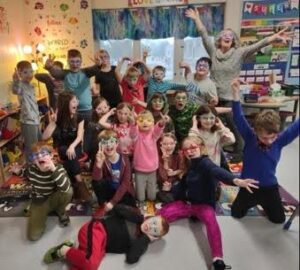 I have been a Teaching Artist for 30+ years, working primarily in school settings. I have taught in many classrooms across the United States and even the globe. Although the settings are different, the learning remains the same; and when the starting point for learning is creativity, the outcomes are genuinely reflective of the individual and their community. MAEIA champions the work of TA’s and celebrates arts in the classroom while:
I have been a Teaching Artist for 30+ years, working primarily in school settings. I have taught in many classrooms across the United States and even the globe. Although the settings are different, the learning remains the same; and when the starting point for learning is creativity, the outcomes are genuinely reflective of the individual and their community. MAEIA champions the work of TA’s and celebrates arts in the classroom while:
- Supporting professional practice and improving teacher effectiveness.
- Advancing arts as a key element of a well-rounded education.
The following example of a teacher and TA collaboration touches on these MAEIA goals while providing insight to authentic classroom experiences.
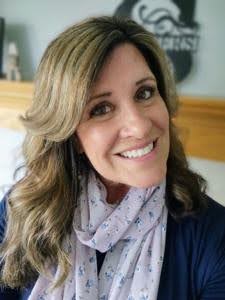 North Aurelius Elementary second grade teacher, Laura Showers is accustomed to having a teaching artist in her classroom. She says, “I have had the opportunity to work with a teaching artist for the past two years. One residency focused on rules and laws, government services, and citizen’s responsibilities. The art discipline was puppet making and puppet performance. The second was fusing theatre and music with math skills of two and three digit addition and subtraction. This resulted in a classroom musical titled Confusion at the Zoo.”
North Aurelius Elementary second grade teacher, Laura Showers is accustomed to having a teaching artist in her classroom. She says, “I have had the opportunity to work with a teaching artist for the past two years. One residency focused on rules and laws, government services, and citizen’s responsibilities. The art discipline was puppet making and puppet performance. The second was fusing theatre and music with math skills of two and three digit addition and subtraction. This resulted in a classroom musical titled Confusion at the Zoo.”
I was privileged to be the teaching artist working with Laura on Confusion at the Zoo. Our eight day residency resulted in a classroom musical where each student played a part, followed direction, recited lines, and sang new songs all while practicing math skills. Laura is a seasoned teacher with her own background and training in arts in the classroom, so when given the opportunity to work with a teaching artist she always accepts. Both Laura and I are experienced in the process and the potential impact of arts integrated work. Together we can recognize and plan for the Fundamentals of Teaching Artistry as outlined by Eric Booth in his book Making Change, Teaching Artists and Their Role in Shaping a Better World.
Fundamentals of teaching artistry in action.
- Activating the artistry of others.
This is the primary goal for teaching artists. TA’s wear a filter that identifies all individuals as artistic, and this is the starting point for the work. As a TA working in schools, I rarely ask for individual notes on students. I enter the classroom with the firm conviction that every student is artistic and creative, and my expectations are that each student will find a way to share their individual creativity. Laura’s artistry is also activated. “I get to tap into the TA’s level of artistic expertise. I learn new, creative ways to teach all subjects. And I am able to express my own creativity with my students.” For her students, Laura sees an increased excitement for learning.
- Adeptness with the creative process.
During the planning stages, Laura and I placed emphasis on the creative process. We facilitated activities that allowed students to create their own animal characters through movement, vocalization, and costume headpiece. The performance is clearly the destination, but the journey in creativity is where the real learning occurs. Laura says, “The students love having a teaching artist in the classroom. It opens up avenues for individualized creativity while allowing students to engage in the creative process and gain understanding through an art form.”
- Creating safe and brave environments for engagement.
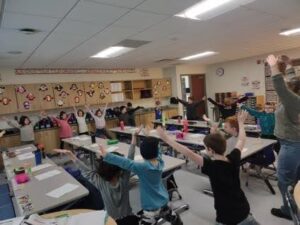 Feeling vulnerable in sharing individual artistry is not uncommon and students respond differently when asked to act, sing, dance, draw, etc. A classroom that feels safe allows for students to be brave and try new things and celebrate each other. On the first day of the residency, I begin with community building activities to take the temperature of the students and assess their level of risk taking. In Laura’s classroom, she has already worked with her students to create this safe and brave environment thus making the creative process unfold easily. Laura also says, “When collaborating with a teaching artist I am motivated to stretch beyond the textbook and incorporate the arts as an alternative or additional method of teaching. It reignites my passion for the arts and reminds me to allow myself to step outside the box of traditional teaching methods.” She also feels safe and brave.
Feeling vulnerable in sharing individual artistry is not uncommon and students respond differently when asked to act, sing, dance, draw, etc. A classroom that feels safe allows for students to be brave and try new things and celebrate each other. On the first day of the residency, I begin with community building activities to take the temperature of the students and assess their level of risk taking. In Laura’s classroom, she has already worked with her students to create this safe and brave environment thus making the creative process unfold easily. Laura also says, “When collaborating with a teaching artist I am motivated to stretch beyond the textbook and incorporate the arts as an alternative or additional method of teaching. It reignites my passion for the arts and reminds me to allow myself to step outside the box of traditional teaching methods.” She also feels safe and brave.
- Deftness with inquiry.
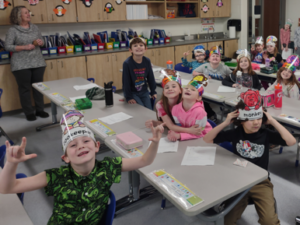 Booth explains, “Creative engagement is a co-learning inquiry process that begins in interest and curiosity.” For the math musical Laura and I spent much time questioning the approach. We were both ‘all in’ knowing the power of the arts to open new ways of learning for students, but at times we were stuck. With constant ‘interest and curiosity’ we found our way to the final plan. Moments of insight grew from our problem solving, like the costume headbands identifying the different animal groups and using large numbers held by the students to visualize the math problems.
Booth explains, “Creative engagement is a co-learning inquiry process that begins in interest and curiosity.” For the math musical Laura and I spent much time questioning the approach. We were both ‘all in’ knowing the power of the arts to open new ways of learning for students, but at times we were stuck. With constant ‘interest and curiosity’ we found our way to the final plan. Moments of insight grew from our problem solving, like the costume headbands identifying the different animal groups and using large numbers held by the students to visualize the math problems.
This inquiry process goes beyond lesson planning and into practice as students are asked to add their own interest and curiosity throughout the creative process. Students would work together in their animal groups to design tableaux, physical frozen images, that told crucial parts of the story. Also, using inquiry serves as an assessment tool providing immediate feedback allowing both Laura and me to make adjustments and improvements for more effective student learning.
- Authenticity.
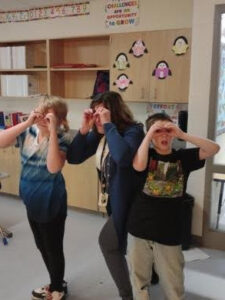 When bringing artistry into a classroom authenticity is key for all involved: TA, classroom teacher and students. Booth writes, “A teaching artist’s greatest impact comes from bringing their artist-selves into the room; openly seeing, responding, discovering and creating connections with what is happening in real time.” I agree whole-heartedly. I also witnessed Laura’s willingness to be authentic and share more of herself through writing songs, designing costume bits, and leading by example in the classroom. With her students she became all animals in the zoo and acted as head zookeeper in the final performance. Students also brought their authentic selves through their willingness to create and perform our musical. Laura recognized that, “For some students, it allows them to succeed in a way they had not been able to previously.”
When bringing artistry into a classroom authenticity is key for all involved: TA, classroom teacher and students. Booth writes, “A teaching artist’s greatest impact comes from bringing their artist-selves into the room; openly seeing, responding, discovering and creating connections with what is happening in real time.” I agree whole-heartedly. I also witnessed Laura’s willingness to be authentic and share more of herself through writing songs, designing costume bits, and leading by example in the classroom. With her students she became all animals in the zoo and acted as head zookeeper in the final performance. Students also brought their authentic selves through their willingness to create and perform our musical. Laura recognized that, “For some students, it allows them to succeed in a way they had not been able to previously.”
Another element of authenticity comes through assessment. When teaching through the arts we value and plan for individualized answers. Laura says, “I have assessed through the arts using a myriad of methods, such as student portfolios, group and individual performances, journal reflections, and peer and self-evaluations.” She also noted that when working with TA’s, “they are often skilled in providing materials and suggestions to students on their level of learning that help them feel successful in their efforts.”
- Imagining meaningful new worlds.
Teaching artists deal in creativity as their main currency. Creativity asks big questions like, “What if? Can we? What’s possible?” Even when integrating with standard subjects like rules and laws and addition and subtraction it is still possible, and important to ask these big questions. In fact, it is the starting point for planning. The work that Laura and I did together to engage her students in learning through drama opened new ideas, new approaches, and new joy for her students struggling in math. Now they can see a new way, a new world of learning.
In another example, for Laura and her students working with a TA and approaching learning through the arts, a new world did open up. After a residency in governmental and public figures, with teaching artist and puppeteer Petra Daher, an exciting thing happened. Laura explains:
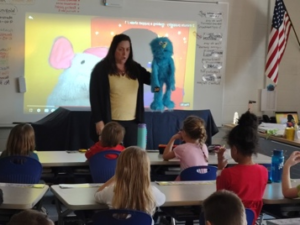 Teaching government to second graders is a monumental task. The standards are that they learn about the structure of government in the United States and how it functions. With that objective in mind, I wanted to use puppetry to introduce students to important people in our communities. We spent a day focusing on Governors and their role and duties.
Teaching government to second graders is a monumental task. The standards are that they learn about the structure of government in the United States and how it functions. With that objective in mind, I wanted to use puppetry to introduce students to important people in our communities. We spent a day focusing on Governors and their role and duties.
I introduced the students to Michigan’s Governor Whitmer and Lieutenant Governor Gilchrist. I projected a picture of each leader onto the screen for the students. The students were to replicate one of the government officials by creating a puppet likeness on a paper plate using a variety of colored crayons and yarn. Petra helped the students by showing them steps to draw and color a face on a paper plate. When all of the puppets were complete, we held a parade from the Governor’s office by placing the plates in a row on the chalk tray. Following the parade, students could name our Governor and Lieutenant Governor and discuss their various community duties.
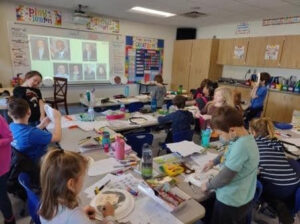 Soon after, I wrote to Governor Whitmer and Lieutenant Governor Gilchrist to explain what we learned in class. I thanked them for their service and sent a picture of their likeness as paper plate puppets. A day or two following the email, Lieutenant Governor Gilchrist called me at my school and left a message. He congratulated me on finding creative ways to teach students about government and encouraged me to continue using art in my teaching. I played his message for the students and the principal of our school. It was a moment to remember for all of us. A connection was made bridging the classroom to the world.
Soon after, I wrote to Governor Whitmer and Lieutenant Governor Gilchrist to explain what we learned in class. I thanked them for their service and sent a picture of their likeness as paper plate puppets. A day or two following the email, Lieutenant Governor Gilchrist called me at my school and left a message. He congratulated me on finding creative ways to teach students about government and encouraged me to continue using art in my teaching. I played his message for the students and the principal of our school. It was a moment to remember for all of us. A connection was made bridging the classroom to the world.
___________________________________________________________________________________________________________
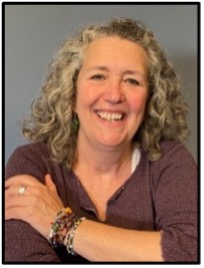 Joni Starr serves as the MAEIA Blog Editor and Researcher for assessment prompt material. As a Teaching Artist she has worked in schools across the United States and internationally in England, China, Guatemala, and Ghana. Joni spent 10 years teaching at Michigan State University sharing time between the Theatre and Teacher Education departments. She has experience in theatre production, curriculum development, formative assessment, and teacher professional development in arts integration and creativity in the classroom. She is also the founder of and lead facilitator at Creekside Gathering Place.
Joni Starr serves as the MAEIA Blog Editor and Researcher for assessment prompt material. As a Teaching Artist she has worked in schools across the United States and internationally in England, China, Guatemala, and Ghana. Joni spent 10 years teaching at Michigan State University sharing time between the Theatre and Teacher Education departments. She has experience in theatre production, curriculum development, formative assessment, and teacher professional development in arts integration and creativity in the classroom. She is also the founder of and lead facilitator at Creekside Gathering Place.
Reference:
Making Change, Teaching Artists and Their Role in Shaping a Better World by Eric Booth.
Images provided by Laura Showers.
Click here for a Printer friendly version of this article.
Leave a Reply
You must be logged in to post a comment. Don't have an account? Register Here.